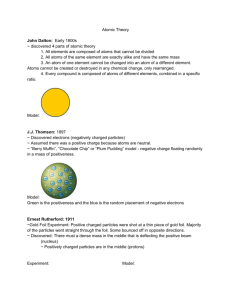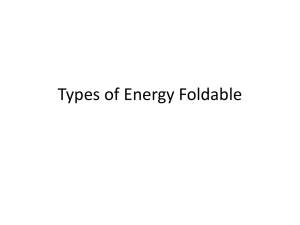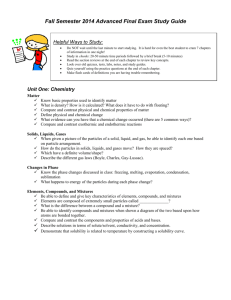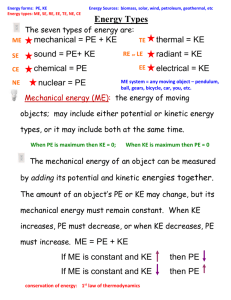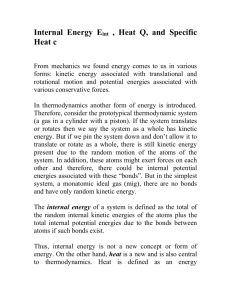Energy Forms
advertisement
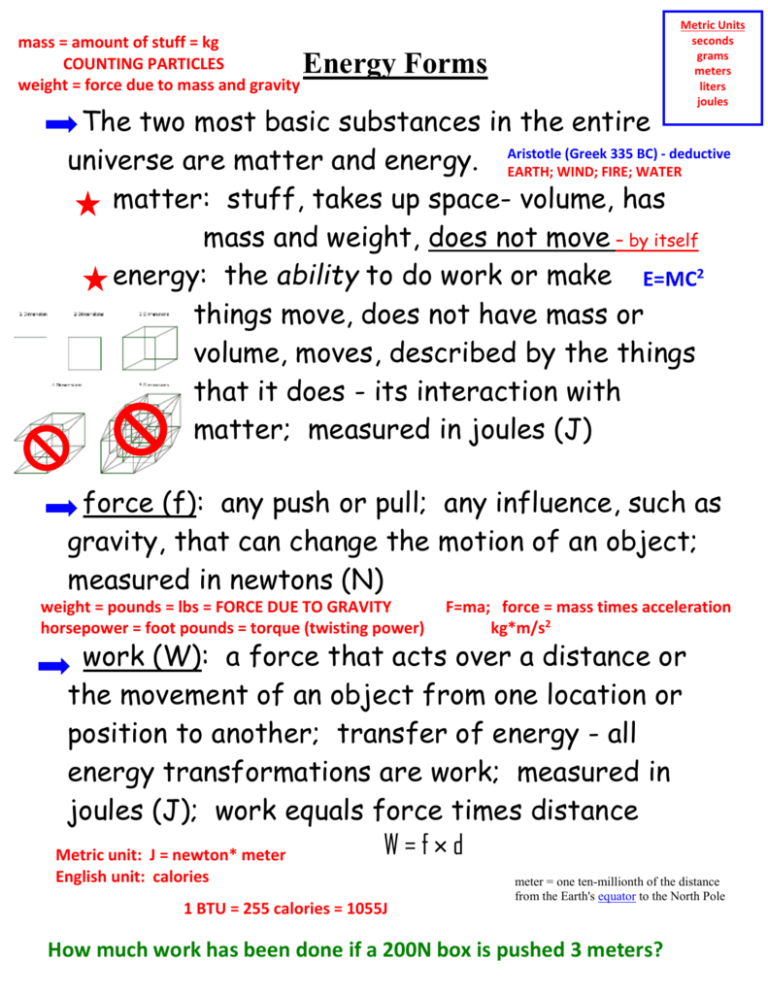
mass = amount of stuff = kg COUNTING PARTICLES weight = force due to mass and gravity Metric Units seconds grams meters liters joules Energy Forms The two most basic substances in the entire (Greek 335 BC) - deductive universe are matter and energy. Aristotle EARTH; WIND; FIRE; WATER matter: stuff, takes up space- volume, has mass and weight, does not move – by itself energy: the ability to do work or make E=MC2 things move, does not have mass or volume, moves, described by the things that it does - its interaction with matter; measured in joules (J) force (f): any push or pull; any influence, such as gravity, that can change the motion of an object; measured in newtons (N) weight = pounds = lbs = FORCE DUE TO GRAVITY horsepower = foot pounds = torque (twisting power) F=ma; force = mass times acceleration kg*m/s2 work (W): a force that acts over a distance or the movement of an object from one location or position to another; transfer of energy - all energy transformations are work; measured in joules (J); work equals force times distance W=f×d Metric unit: J = newton* meter English unit: calories 1 BTU = 255 calories = 1055J meter = one ten-millionth of the distance from the Earth's equator to the North Pole (at sea level), How much work has been done if a 200N box is pushed 3 meters? Energy forms: PE, KE Energy types: ME, SE, RE, EE, TE, NE, CE Energy Sources: biomass, solar, wind, petroleum, geothermal, etc Energy Forms - 2 Energy can either be used right away or stored for use later. Energy is described by: Distance = 0 1 2 so work = 0 NO WORK its position / shape or chemistry / W=f*d 3 composition - Potential Energy GPE = weight times height WORK its motion - Kinetic Energy These are ways that energy is measured – not types of energy! Energy that is stored and is not being used is called potential energy (PE). It is the energy an 1 2 object has because of its position or shape and its 3 chemistry or composition (what it is made of). PE is measured in joules (J) Examples: stretched rubber band or spring charged battery tank of gasoline sugar heavy object any type or fuel or food Kinetic energy (KE) is energy in motion that is being used. All moving objects have kinetic energy and are doing work. The amount of kinetic energy of an object depends on its mass and speed. The faster an object moves or the more massive it is, the more kinetic energy it has. Kinetic energy is also measured in joules (J). 2 KE = ½ mv Energy Forms- 3 The seven forms of energy are: ME mechanical = PE + KE SE sound = PE+ KE CE chemical = PE NE nuclear = PE TE RE EE thermal = KE radiant = KE electrical = KE ME system = any moving object – pendulum, ball, gears, bicycle, car, you, etc. Mechanical energy (ME): the energy of moving objects; may include either potential or kinetic energy types, or it may include both at the same time. When PE is maximum then KE = 0; When KE is maximum then PE = 0 The mechanical energy of an object can be measured by adding its potential and kinetic energies together. The amount of an object’s PE or KE may change, but it mechanical energy must remain constant. When KE increases, PE must decrease, or when KE decreases, PE must increase. ME = PE + KE conservation of energy? 1st law of thermodynamics? If ME is constant and KE then PE If ME is constant and KE then PE Energy Forms – 4 A pendulum clock is a compound machine that uses stored energy to do work. A spring stores energy, and with each swing, some of the PE is converted to KE to move the hands. At the top of the swing PE is greatest and KE = 0. At the bottom of the swing, KE is the greatest and PE = 0. At any time, the PE and KE can be added to find the total energy of the system. The If the KE = 200J and increases, and the PE = 200J, what is the ME? Where is it in its swing? _____ _____ same concept applies with stretching materials like PE = Max PE = Max springs and rubber bands. In a pendulum if the ME = 200J and the KE = 150J and decreasing, what is the PE and where is it in its swing? _____ _____ A E B C KE = Max D Sound = compression wave = P wave, like dominoes Is there sound in outer space? Energy Forms - 5 Sound energy (SE): the vibration of particles along a path; Vibrating particles transmit their KE to the resting PE particle next to it. The energy is transmitted from particle to particle forming a chain or compression wave. PE and KE are determined by the spacing or position of the particles. The closer the particles, the faster the wave, and the higher the KE. SE = KE + PE KE – closely spaced particles push speed of sound: air 68°F = 1130 ft/s, 770 mph water = 5000 ft/s, 3409 mph PE – widely spaced particles are at rest - equilibrium steel = 20,000 ft/s, 13,636 mph Polymer = chains of molecules: CH4 methane; C3H8 propane; C7 H16 gasoline; C12 diesel/fuel oil; C16 lubricating oil; C20+ asphalt/tar/wax Energy Forms - 6 1 BTU = 255 calories = 1055J Most oil is turned into plastic not gasoline! Chemical energy: Stored energy (PE) that holds atoms and molecules together. All stuff has chemical energy! Larger molecules have more chemical energy than smaller ones. Examples: releasing their stored energy ANYTHING INTO OIL? sugar (carbohydrates) gasoline (hydrocarbons) Thermal Depolymerization? peak oil - point at which the earth's supply of oil will no be able to meet our energy needs. Oil is not a ATP (cells) acids/bases - batteries longer renewable energy source, will be exhausted at some any type or fuel or food all molecules!!! point in the future. Fuel = molecules that break apart easy C6H12O6 = sugar carbs = long sugar chains fats = long carb chains ANWR? Where does stuff go when it burns up? Chemical reactions (breaking of atomic bonds) such as burning gasoline or digesting food releases the stored chemical energy and changes it into another form of energy (usually heat) which leaves the system. Energy is lost but total mass always stays the same. Combustion (burning) changes the size and shape of the materials, but the total mass is exactly the same before and after. 1st LAW Thermodynamics Law of Conservation of Mass: Mass (matter) cannot be created or destroyed. mass in (reactants) = mass out (products) Matter is never lost! It goes somewhere, even if you can’t see it!! Difference between CE and NE? CE = atoms; NE = protons and neutrons; NE = most energy of all types Energy Forms - 7 Nuclear energy: the energy that holds protons and neutrons together inside the nucleus of an atom; PE; produced in two ways. energy source every discovered. It is the most powerful Nuclear fusion: energy stored in hydrogen atoms join to form helium releasing large amounts of electromagnetic energy Nuclear waste/pollution? Nuclear energy is clean!!!! Environmentally friendly!! sun’s energy! safety? driving vs flying Nuclear fission: the nuclei of large atoms are split converting the potential nuclear energy into kinetic reactors – technology; 230 years to 1000 yrs? electromagnetic energy nuclear still nonrenewable; 10 million times as much heat as coal Cold metal versus warm plastic? Conductors versus insulators? Thermal energy: TE is also called heat energy. All atoms and molecules are in motion at all times. At room temperature, atoms jiggle at about 1000 mph. Heat energy is the total kinetic energy (KE) of the particles that make an object or the random motion or vibration of atoms or molecules within matter. Friction = heat from things touching = energy conversion ME (KE) changing into TE (KE) atoms - tiny particles that make all matter; include protons, neutron, electrons molecules - combinations of atoms At high temps, atoms giggle faster and melt or evaporate At low temps, atoms giggle slower and condense or freeze Energy Forms - 8 Electrical energy: the movement of electrons through matter; KE; electricity is created when electrons are knocked out of their orbit Electrons are tiny particles that spin around the nucleus of atoms and bind them together. Two kinds of electricity: static electricity: the random and scattered movement of electrons, they spread out; no work is electrical safety? 50,000 Volts versus 0.1 Amps – heart done. lightning? attack/death; 0.018A breathing difficulty/suffocation; 0.0001A human perception current electricity is the continuous flow of electrons along a directed path called a circuit; work is done. EE is measured by its electromotive force (EMF) or volatage in volts (V), by its volume of flow of electrons in amperes (A), and by its resistance to electron flow in ohms (Ω). EE: secondary source of energy - must use another energy source to make it. Coal is the number one energy source used for generating electricity. EE: Energy carrier because it is an efficient and safe way to move energy from one place to another. Energy Forms - 9 Making electricity: We use magnets to make electricity. Power plants use huge turbine generators that spin really fast by the use of steam or by the use of wind, or rushing water in a dam. Steam can be produced by various fuel sources such as coal, oil, natural gas, or uranium (nuclear). The turbine is attached to a shaft with coils of wire surrounded by permanent magnets. As the shaft spins, electrons are pushed by the magnetic field. The moving electrons are the electricity that flows to our houses. It moves very fast. In just one second, electricity can travel around the world seven times. 12,000 volts residence 120 volts 230,000 volts Receiving Station 69,000 volts Distribution Station local substations Energy Forms - 10 Energy Forms - 11 Difference between light and sound? Radiant energy: the energy from electromagnetic waves; KE; travels at 186,000 miles per second; can be travel through a vacuum - does not need matter. electromagnetism - a wave of pure energy defined by its wavelength and frequency (the amount of energy in a space). It includes radio waves (not sound waves), TV waves, infrared (heat), visible light, ultra violet, X-rays, gamma rays. Light is pure energy that moves in waves spectrum = range of energy types PEAK OIL World discovery of oil peaked in the 1960s, and has declined since then. If the 40 year cycle seen in the US holds true for world oil production, that puts global peak oil production, right about now; after which oil becomes less available, and more expensive. Today we consume around 4 times as much oil as we discover. If we apply Hubbert's Peak to world oil production we estimate that approximately half of all oil that will be recovered, has been recovered, and oil production may reach a peak in the near future, or perhaps already has. http://peakoil.com/what-is-peak-oil/ HYDROCARBONS In a 42 gallon barrel of crude oil 20 gal 0.2 gal 4 gal 9 gal 0.5 gal 2 gal 6 gal NUCLEAR REACTION ELECTRICAL SAFETY As shown in the chart, shock is relatively more severe as the current rises. For currents above 10 milliamps, muscular contractions are so strong that the victim cannot let go of the wire that is shocking him. At values as low as 20 milliamps, breathing becomes labored, finally ceasing completely even at values below 75 milliamps. As the current approaches 100 milliamps, ventricular fibrillation of the heart occurs - an uncoordinated twitching of the walls of the heart's ventricles which results in death. Above 200 milliamps, the muscular contractions are so severe that the heart is forcibly clamped during the shock. This clamping protects the heart from going into ventricular fibrillation, and the victim's chances for survival are good.



